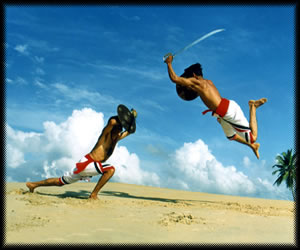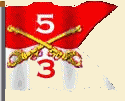


Notice: This is the official website of the All Empires History Community (Reg. 10 Feb 2002)
Bodhidharma |
Post Reply 
|
Page <12 |
| Author | ||
oxydracae 
Samurai 
Joined: 26-Feb-2012 Online Status: Offline Posts: 107 |
 Quote Quote  Reply Reply
 Topic: Bodhidharma Topic: BodhidharmaPosted: 03-Mar-2012 at 05:44 |
|
|
^^ from my observations till now, I would say any tree if falls makes a noise, so a remote tree in remote forest will also make a noise. What was Bodhi's reply ?
P.S: Pallav and Pahlav were quiet confusing words, may be they caused confuiom in Chinese as Bodhidjarma is from Pallav (South India) or Pahlav (Persia).
|
||
 |
||
Nick1986 
Emperor 

Mighty Slayer of Trolls Joined: 22-Mar-2011 Location: England Online Status: Offline Posts: 7940 |
 Quote Quote  Reply Reply
 Posted: 03-Mar-2012 at 19:15 Posted: 03-Mar-2012 at 19:15 |
|
|
Bodhi probably didn't know the right answer either. He asked deliberately unsolveable questions in the hope of opening the minds of his students
Edited by Nick1986 - 03-Mar-2012 at 19:16 |
||
|
Me Grimlock not nice Dino! Me bash brains!
|
||
 |
||
Nick1986 
Emperor 

Mighty Slayer of Trolls Joined: 22-Mar-2011 Location: England Online Status: Offline Posts: 7940 |
 Quote Quote  Reply Reply
 Posted: 06-Jul-2012 at 19:23 Posted: 06-Jul-2012 at 19:23 |
|
|
Me Grimlock not nice Dino! Me bash brains!
|
||
 |
||
TheAlaniDragonRising 
AE Moderator 
Spam Fighter Joined: 09-May-2011 Online Status: Offline Posts: 6084 |
 Quote Quote  Reply Reply
 Posted: 07-Jul-2012 at 05:17 Posted: 07-Jul-2012 at 05:17 |
|
|
||
|
What a handsome figure of a dragon. No wonder I fall madly in love with the Alani Dragon now, the avatar, it's a gorgeous dragon picture.
|
||
 |
||
SuryaVajra 
Samurai 
Joined: 05-Jul-2012 Online Status: Offline Posts: 124 |
 Quote Quote  Reply Reply
 Posted: 07-Jul-2012 at 07:17 Posted: 07-Jul-2012 at 07:17 |
|
That would require an assumption that India had no martial tradition before the Hellenic age.That theory would require a clear comparison of Greek and ancient Bharatha styles, which so far has not been produced. But it is clear in the Mahabharata and the Puranas that many of the popular sports mentioned in the Vedas and the epics have their origins in military training, such as wrestling (maladvandva), chariot-racing (rathachalan), horse-riding (ashvarohana), boxing (musti yuddha) and archery (dhanurvidya). Competitions were held not just as a contest of the players' prowess but also as a means of finding a bridegroom. Arjuna, Rama and Siddhartha Gautama all won their consorts in such tournaments.(from Wikipedia) |
||
 |
||
Nick1986 
Emperor 

Mighty Slayer of Trolls Joined: 22-Mar-2011 Location: England Online Status: Offline Posts: 7940 |
 Quote Quote  Reply Reply
 Posted: 12-Jul-2012 at 19:15 Posted: 12-Jul-2012 at 19:15 |
|
|
Every civilisation needs a well-trained military, but did the ancient Indians have a manual for some standardised form of unarmed combat similar to kung-fu or MMA?
|
||
|
Me Grimlock not nice Dino! Me bash brains!
|
||
 |
||
SuryaVajra 
Samurai 
Joined: 05-Jul-2012 Online Status: Offline Posts: 124 |
 Quote Quote  Reply Reply
 Posted: 13-Jul-2012 at 01:47 Posted: 13-Jul-2012 at 01:47 |
|
|
This indigenous martial arts, under the name of Kalari exists only in South India today. Kalarippayat
is said to be the world's original martial art. Originating at least 1,300 years ago, India's
Kalaripayit is the oldest martial art taught today. It is also the most
potentially violent, because students advance from unarmed combat to the use of
swords, sharpened flexible metal lashes, and peculiar three-bladed daggers. More
than 2,000 years old, it was developed by warriors of the Cheras kingdom in
Kerala. Training followed strict rituals and guidelines. The entrance to the 14 m-by-7 m arena, or kalari, faced east and had a bare earth floor. Fighters took Shiva and Shakti, the god and goddess of power, as their deities. From unarmed kicks and punches, kalarippayat warriors would graduate to sticks, swords, spears and daggers and study the marmas—the 107 vital spots on the human body where a blow can kill. Training was conducted in secret, the lethal warriors unleashed as a surprise weapon against the enemies of Cheras.  Father and founder of Zen Buddhism (called C’han in China), Boddidharma, a Brahmin born in Kacheepuram in Tamil Nadu, in 522 A.D. arrived at the courts of the Chinese Emperor Liang Nuti, of the 6th dynasty. He taught the Chinese monks Kalaripayattu,
If you read the Mahabharata, you'll see how important combat was in Vedic society. Why do you think there was a warrior caste?The Kshtriyas It was only the Kshtriyas who had a code of war in the ancient world.Here are three of the many clauses (1) a warrior in armor must not fight with one not so clad (2) one should fight only one enemy and cease fighting if the opponent is disabled, (3) aged men, women and children, the retreating, or one who held a straw in his lips as a sign of unconditional surrender should not be killed. As early as as the 4th century B.C. Megasthenes noticed a peculiar trait of Indian warfare. "Whereas among other nations it is usual, in the contests of war, to ravage the soil and thus to reduce it to an uncultivated waste, among the Indians, on the contrary, by whom husbandmen are regarded as a class that is sacred and inviolable, the tillers of the soil, even when battle is raging in their neighborhood, are undisturbed by any sense of danger, for the combatants on either side in waging the conflict make carnage of each other, but allow those engaged in husbandry to remain quite unmolested. Besides, they never ravage an enemy's land with fire, nor cut down its trees."When
a conqueror felt that he was in a position to invade the foreigner's country, he
sent an ambassador with the message: 'Fight or submit.' More than 5000 years ago
India recognized that the person of the ambassador was inviolable. This
was a great service that ancient Hinduism rendered to the cause of international
law. It was the religious force that invested
the person of the herald or ambassador with an inviolable sanctity in the
ancient world. The Mahabharata rules
that the king who killed an envoy would sink into hell with all his
ministers. Besides, the Kshtriyas have successfully defended India for the past 7000 years of recorded history. Hindu military science recognizes two kinds of warfare - the dharmayuddha and the kutayuddha. Dharmayuddha is war carried on the principles of dharma, meaning here the Ksatradharma or the law of Kings and Warriors. In other words, it was a just and righteous war which had the approval of society. On the other hand, kuttayuddha was unrighteous war. It was a crafty fight carried on in secret. The Hindu science of warfare values both niti and saurya i.e. ethical principles and valor. It was therefore realized that the waging of war without regard to moral standards degraded the institution into mere animal ferocity. A monarch desirous of dharma vijaya should conform to the code of ethics enjoined upon warriors.  The principles regulating the two kinds of warfare are elaborately described in the Dharmasutras and Dharmasastras, the epics (Ramayana and Mahabharata), the Arthasastra treatises of Kautalya, Kamandaka, and Sukra. Hindu India possessed the classical fourfold force of chariots, elephants, horsemen, and infantry, collectively known as the Caturangabala. You can read more at this sites, from where I obtained this information http://en.wikipedia.org/wiki/Indian_martial_arts http://www.hinduwisdom.info/War_in_Ancient_India.htm Edited by SuryaVajra - 13-Jul-2012 at 01:57 |
||
 |
||
Nick1986 
Emperor 

Mighty Slayer of Trolls Joined: 22-Mar-2011 Location: England Online Status: Offline Posts: 7940 |
 Quote Quote  Reply Reply
 Posted: 29-Sep-2012 at 20:51 Posted: 29-Sep-2012 at 20:51 |
|
|
These codes of conduct are in some ways beneficial to the conqueror: he could use the intact land and peasants of his defeated enemy to produce food and levy taxes
|
||
|
Me Grimlock not nice Dino! Me bash brains!
|
||
 |
||
BoPoMoFo 
Knight 
Joined: 25-Oct-2012 Online Status: Offline Posts: 62 |
 Quote Quote  Reply Reply
 Posted: 02-Nov-2012 at 21:49 Posted: 02-Nov-2012 at 21:49 |
|
There can be no logical explanation/interpretation of koans. Your answer will only get you a whack on the head. The purpose of the koans is to let you think of how the impossible can be possible so desperately that suddenly, you get an epiphany and release (presumably from nirvana but at least the baggages from this world).
|
||
 |
||
Centrix Vigilis 
Emperor 

Joined: 18-Aug-2006 Location: The Llano Online Status: Offline Posts: 7392 |
 Quote Quote  Reply Reply
 Posted: 02-Nov-2012 at 22:01 Posted: 02-Nov-2012 at 22:01 |
|
Well presuming I buy that.... and I'm not far.... my question to the great Master would be...'what's your take on the undead in general and chinese hoping zombies in specific? Are these aberrant forms of unlife due to really baddddd karma?' Or is there another explanation.
|
||
|
"Absence of evidence is not evidence of absence"
S. T. Friedman Pilger's law: 'If it's been officially denied, then it's probably true' |
||
 |
||
Post Reply 
|
Page <12 |
| Forum Jump | Forum Permissions  You cannot post new topics in this forum You cannot reply to topics in this forum You cannot delete your posts in this forum You cannot edit your posts in this forum You cannot create polls in this forum You cannot vote in polls in this forum |
Copyright ©2001-2009 Web Wiz
This page was generated in 0.133 seconds.











 Printable Version
Printable Version Google
Google Delicious
Delicious Digg
Digg StumbleUpon
StumbleUpon Windows Live
Windows Live Yahoo Bookmarks
Yahoo Bookmarks reddit
reddit Facebook
Facebook MySpace
MySpace Newsvine
Newsvine Furl
Furl Topic Options
Topic Options